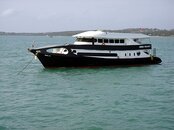Hitomi Shibata, 22, died instantly after her head struck a boat propeller while she was diving off Racha Island, about 12 kilometres south of Phuket, on May 4.
Police spent a month interviewing others who were with Ms Shibata on a three-day open-water scuba diving course with Kontiki Divers, aboard a rented boat belonging to Marine Project Co.
The investigation confirmed that Ms Shibata accidentally fully inflated her buoyancy compensator device (BCD), which caused her rapid ascent. BCDs are usually used to help divers maintain neutral buoyancy, but can also be used in extreme emergency as a device to get to the surface fast.
Ms Shibata’s diving partner, who accompanied her, was dragged with her to the surface as well. Fortunately, he only hit the side of the boat and suffered minor injuries.
Police believe that Ms Shibata pushed the inflator button on the BCD too hard, causing the BCD to inflate rapidly, carrying her head-first into the propeller of the boat, which was manoeuvring to pick up another group who had just finished their dive.
Ms Shibata’s family, who came to collect her remains three days after her death, lodged no complaint, police said.
Critics in the diving industry have stressed that boats used for diving should never use their engines while divers are in the water. There is, however, no law to cover this aspect of diving safety.





